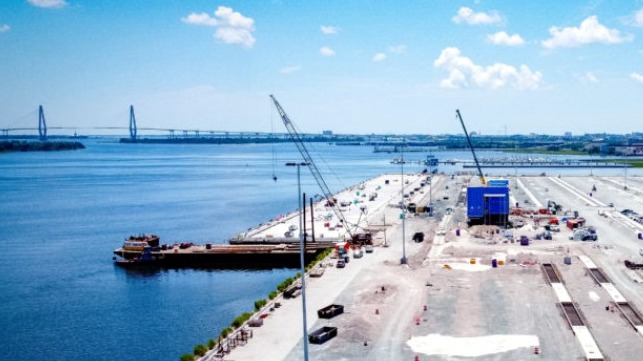Charleston Progress on New Container Terminal; Cruise Project Stalled

Construction of the first new container terminal in the US in more than a decade is continuing to make progress in the Port of Charleston, South Carolina towards its scheduled opening in March 2021 according to South Carolina Ports. Yet, while the container terminal project is moving forward, the state is being confronted by legal challenges for its broader plans for the redevelopment of another part of Charleston’s waterfront including a new cruise ship terminal.
The new container terminal, known as the Hugh K. Leatherman Terminal, will add in phase one 700,000 TEUs of annual throughput capacity to the Port of Charleston providing the capability to handle a 19,000 TEU ship. By the time the project is completed, the three-berth terminal will double S.C. Ports current capacity by adding 2.4 million TEUs of throughput capacity.
“We look forward to opening the first phase of the Hugh K. Leatherman Terminal, which will be the country’s first container terminal in more than a decade,” S.C. Ports President and CEO Jim Newsome said. “The Leatherman Terminal will enable S.C. Ports to handle more cargo and bigger ships. Businesses depend on us to efficiently move their cargo, and this flow of goods creates more jobs and investment in South Carolina.”
S.C. Ports highlighted that its engineering and construction teams recently reached several key construction milestones as the terminal continues to take shape in North Charleston. Among the milestones was the final concrete pour for the 1,400-foot wharf which will accommodate five ship-to-shore cranes. The first two cranes are expected to arrive from China in September, with the remaining three arriving in October. The terminal will also have twenty-five hybrid rubber-tired gantry cranes scheduled to arrive later this year.
Foundations have been installed and steel erection work has started for the six-story tall refrigerated container racks that will more refrigerated and frozen goods. Vertical construction is nearly 70 percent complete as many on-site buildings are taking shape, including the terminal operations building, vessel operations building, maintenance building, and the various booths and canopies designed for truck drivers and tenants.
S.C. Ports is in the final year of a six-year capital improvement plan, a culmination of years of strategic infrastructure planning and $2 billion in investments. The Leatherman Terminal complements efforts to modernize Wando Welch Terminal and deepen Charleston Harbor to 52 feet. These investments will enable S.C. Ports to handle four 14,000-TEU vessels simultaneously in 2021.
Along another part of the waterfront, the Ports Authority, however, finds itself caught in a legal battle for a new cruise terminal and redevelopment of the area. The state proposed developing a new terminal just to the north of the dated facility which was opened in the 1970s when cruise ships were much smaller and carried far fewer people. The masterplan for the area calls for the area where the old terminal is to be redeveloped included a waterfront park and a hotel.
Opponents of the plan for covert the area where an old warehouse stands into the modern cruise terminal have argued about the impact on the community including pollution and congestion. The South Carolina Supreme Court recently ruled that residents have the right to bring a case in court in opposition to the project overturning a lower court order. As a result of the decision, the lower court will be holding hearings to determine if the project and permits already granted need to reviewed.
Carnival Cruise Line has based one of its cruise ships in Charleston and is reported to be interested in a new 20-yar agreement with the port to continue cruise ship operations. Having gained key permits, the State Ports Authority thought that was making progress on its plan but will now have to contend with additional court hearings.
